Recent Water Damage Posts
Preventing Water Damage in Your Home Starts Here
5/3/2024 (Permalink)
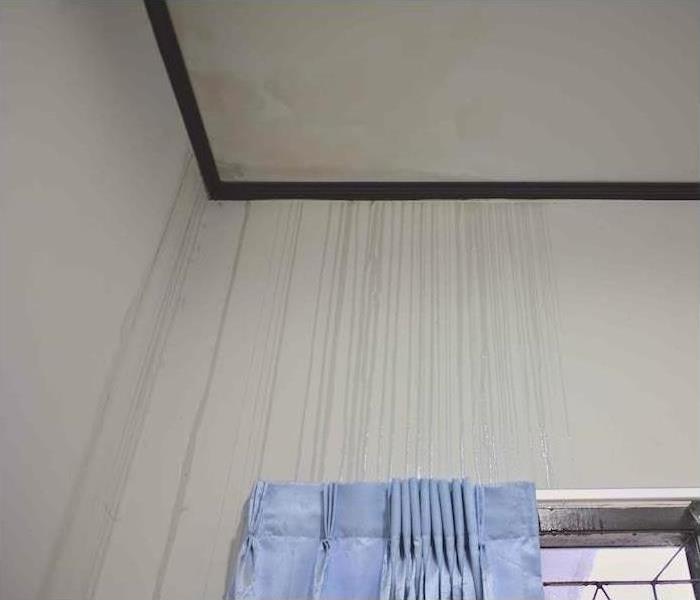 It’s important to educate yourself about home systems that are designed to prevent water from entering your home.
It’s important to educate yourself about home systems that are designed to prevent water from entering your home.
The perks of owning your own home are great but it also brings a lot of responsibility. Homes are built in a way to provide maximum protection from water intrusion but sometimes those methods fail.
It’s important to educate yourself about home systems that are designed to prevent water from entering your home. Here are some of the most common points of failure in a home that could allow water to go where it shouldn’t:
- Faucets and Sinks. Faucets and sinks are places to check for leaks. Over time, the rubber gaskets in faucets can degrade which can lead to leaks. Sink drains are usually sturdy unless you have a clog and use too much plunger pressure to remove it. Too much pressure from plunging can damage seals, so always use caution.
- Disposals. Garbage disposals are one of the hardest working appliances, and they can spring a link. If you believe you have a leak, check out these tips for finding it.
- Gutters and Downspouts. Gutters and downspouts should be clean and free flowing. They should be inspected regularly and cleared of obstructions and debris. Downspouts should move water at least 30 inches away from the home, and the soil should also flow away from the home.
- Roof Damage. Falling limbs from trees are a real risk to roof systems. They can perforate the roof and damage or clog gutters. Shingles are especially susceptible to falling tree damage. Newer shingles are designed and constructed to be impact-resistant, hopefully reducing the need for expensive roof repairs. But shingles degrade over time, and a falling tree or limb can easily damage an aged shingle.
- Sewer Line Obstruction. This is a serious issue and usually takes a professional plumber to resolve it. Sewer lines can clog for a number of reasons, but two of the most common are root intrusion and grease buildup.
- Sump Pump Defect. A sump pump is designed to move water from a basement or crawlspace to outside the home into a drainage system. When a sump pump fails, water backups can affect your home quickly.
Winter Water Damage
12/19/2023 (Permalink)
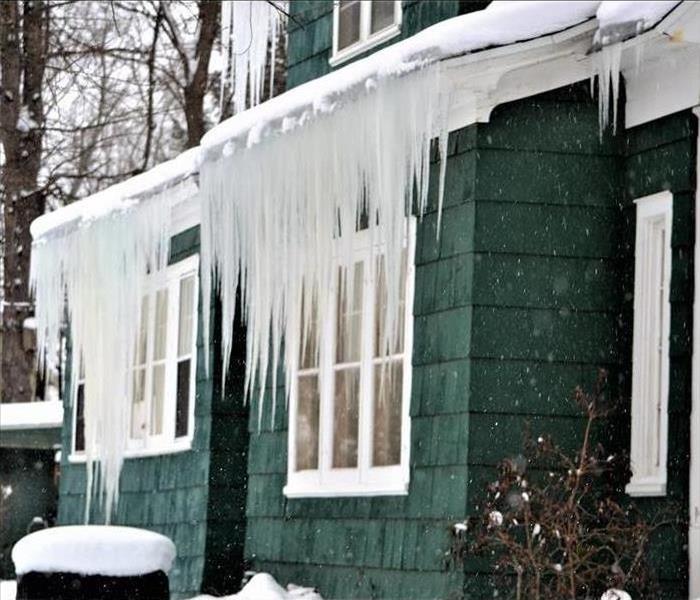 With below freezing temperatures, snow, and ice, your home or business could be in jeopardy of water damage.
With below freezing temperatures, snow, and ice, your home or business could be in jeopardy of water damage.
Indiana winters are known to be brutally cold and large amounts of snow are always expected. With below freezing temperatures, snow, and ice, your home or business could be in jeopardy of water damage. It is crucial that you are aware of the hazards and can prepare, prevent or act quickly if faced with winter water damage.
FROZEN PIPES
A frozen pipe can burst at the point where the ice blockage inside the pipe is located, but typically the rupture is caused by the backflow pressure between the water source and the blockage. A burst pipe can cause considerable damage to your property if not addressed quickly.
ICE DAMS
Ice dams can be a major problem during the winter season. They form when heated air melts roof snow downward into water dammed behind still-frozen ice. When the trapped water cannot safely flow or run into the gutter system, it can backflow under the roof ’s shingles and into the structure’s interior areas.
Cold weather, snow, and ice storms can cause severe damage to your home or business. When these types of disasters strike, immediate action is necessary to prevent additional damage to your property. Our team has winter storm experience, expertise, and the resources to remediate damage caused by winter weather. If disaster strikes your home or business during the winter months, know that SERVPRO® has your back.
Sewage Cleanup and Restoration
7/28/2023 (Permalink)
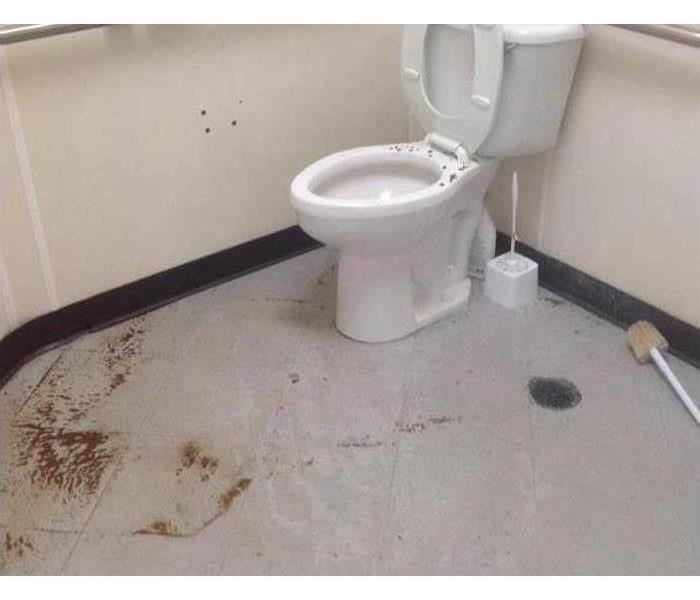 There are three major types of contaminated water.
There are three major types of contaminated water.
There are three major types of contaminated water. SERVPRO® will inspect contaminated water to determine the type of water and then plan the appropriate response to safely restore your home or business. The three types of contaminated water are:
Category 1: "Clean Water"
This is water from a clean source, such as a broken clean water supply line or faucet. If left untreated, category 1 water can quickly degrade into category 2 or 3 water depending upon such factors as time, temperature, and contact with contaminants.
Category 2: "Gray Water"
This water has a significant level of contamination that could cause discomfort or illness if ingested. Sources for category 2 water may include washing machine overflow, toilet overflow with some urine, but no feces, or dishwasher overflow.
Category 3: "Black Water"
This water is grossly unsanitary and could cause severe illness or death if ingested, and any contact should be avoided. Sources for category 3 water could include flooding from rivers or streams, water from beyond the toilet trap, water from the toilet bowl with feces, or standing water that has begun to support microbial growth.
Sewage backup should be considered an emergency and dealt with as quickly as possible. SERVPRO® the water damage restoration specialists with specific training and expertise to safely restore your home or business.
The Right Equipment
7/5/2023 (Permalink)
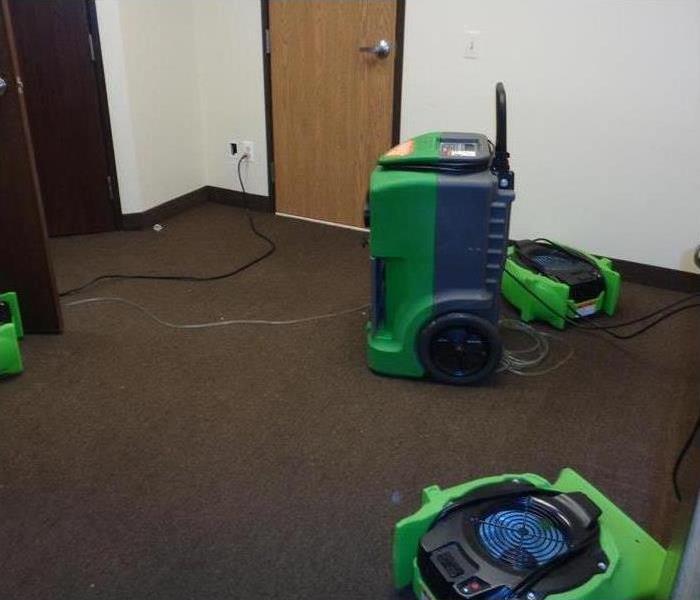 SERVPRO understands that using the proper equipment makes a measurable difference in reducing claims loss expense.
SERVPRO understands that using the proper equipment makes a measurable difference in reducing claims loss expense.
SERVPRO® understands that using the proper equipment makes a measurable difference in reducing claims loss expense. When time matters, technology and equipment must be counted on to perform. Learn more about the water mitigation equipment used by our team members!
Detection Equipment
- Moisture Sensors - Used to detect moisture in carpets, baseboards and walls.
- Moisture Meters - Used to determine the actual moisture content of various materials. The moisture tester provides accurate moisture readings that enables our team to monitor the drying process.
- Thermohygrometers - Measures both temperature and relative humidity. Capturing these two readings, we use a psychrometric chart to calculate specific humidity, dew point and vapor press.
Extraction Equipment
- Extractors - Used in cleaning carpets and upholstery and in removing water from floors following water damage. Extractors can either be truck-mounted or portable, allowing for greater access inside structures.
Dehumidification Equipment
- Refrigerant Dehumidifiers - Works similarly to air conditioners.
- Desiccant Dehumidifiers - Uses chemicals, called desiccants, that readily absorb moisture from the air.
SERVPRO® has the training, expertise and proper equipment to help with your water damage problem. If your commercial or residential property has an issue with water damage, call us today.
Prevent Frozen Pipes
1/9/2023 (Permalink)
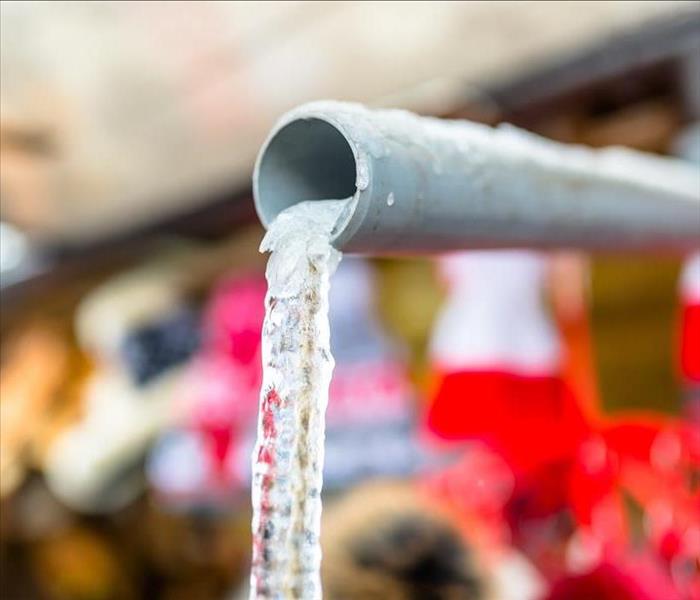 A burst pipe can cause considerable damage to your property if not addressed quickly.
A burst pipe can cause considerable damage to your property if not addressed quickly.
A frozen pipe can burst at the point where the ice blockage inside the pipe is located, but typically the rupture is caused by the backflow and the blockage. A burst pipe can cause considerable damage to your property if not addressed quickly.
Prevent frozen pipes this winter with these tips:
- Keep water faucets running with a slow drip
- Keep garage door closed
- Keep thermostat set to the same temperature morning and night
- Leave the cabinet doors open near pipes
- Unhook the hose from outside the house
- Install heat tape
- Seal leaks to prevent cold air from entering your home
- Check the temperature in the house to ensure there is enough heat on those colder days
Disasters can still happen to the most prepared person. If your home or business has water damage because of a burst frozen pipe, the team at SERVPRO is “Here to Help” get your property back to preloss condition.
 It’s important to educate yourself about home systems that are designed to prevent water from entering your home.
It’s important to educate yourself about home systems that are designed to prevent water from entering your home.


 24/7 Emergency Service
24/7 Emergency Service



